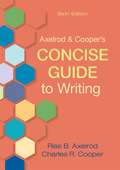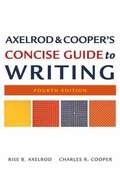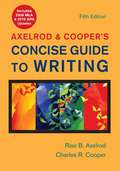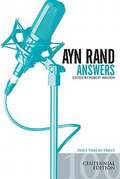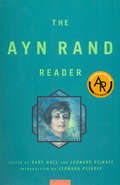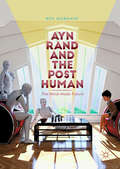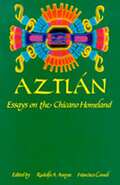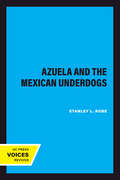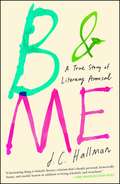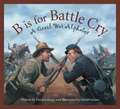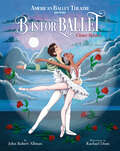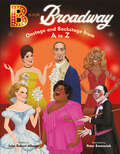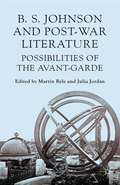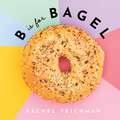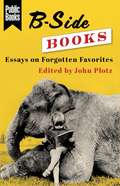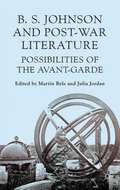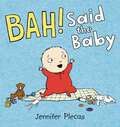- Table View
- List View
Axelrod & Cooper's Concise Guide To Writing 6th Edition
by Rise B. Axelrod Charles R. CooperAdapted from the best-selling St. Martin’s Guide to Writing, Axelrod and Cooper’s Concise Guide to Writing provides streamlined versions of the chapters covering six of the most commonly assigned genres in the first-year writing course — remembering events, writing profiles, explaining concepts, arguing a position, proposing a solution, and justifying an evaluation. The careful integration of well-chosen readings with guided writing instruction in these chapters is complemented by coverage of strategies for reading, writing, and research in brief-but-complete chapters at the end of the book.
Axelrod & Cooper's Concise Guide to Writing (4th edition)
by Rise B. Axelrod Charles R. CooperThis is a guide to help students learn to write different types of essays and to know how to research for, and reflect upon different types of writing.
Axelrod & Cooper's Concise Guide to Writing (5th edition)
by Rise B. Axelrod Charles R. CooperAxelrod and Cooper's Concise Guide to Writing provides streamlined versions of the acclaimed Guides to Writing for six of the most commonly assigned genres in the first-year writing course. The careful integration of well-chosen readings with coverage of critical reading and guided writing in the Guide chapters is complemented by fuller coverage of reading, writing, and research in chapters at the end of the book.
Ayn Rand Answers: The Best of Her Q & A
by Robert MayhewAfter the publication of Atlas Shrugged in 1957, Ayn Rand occasionally lectured in order bring her philosophy of Objectivism to a wider audience and apply it to current cultural and political issues. These taped lectures and the question-and-answer sessions that followed not only added an eloquent new dimension to Ayn Rand's ideas and beliefs, but a fresh and spontaneous insight into Ayn Rand herself. Never before available in print, this publishing event is a collection of those enlightening Q & As. This is Ayn Rand on: ethics, Ernest Hemingway, modern art, Vietnam, Libertarians, Jane Fonda, religious conservatives, Hollywood Communists, atheism, Don Quixote, abortion, gun control, love and marriage, Ronald Reagan, pollution, the Middle East, racism and feminism, crime and punishment, capitalism, prostitution, homosexuality, reason and rationality, literature, drug use, freedom of the press, Richard Nixon, New Left militants, HUAC, chess, comedy, suicide, masculinity, Mark Twain, improper questions, and more.
Ayn Rand Reader
by Ayn Rand Leonard Peikoff Gary HullThe Fountainhead, which became one of the most influential and widely read philosophical novels of the twentieth century, made Ayn Rand famous. An impassioned proponent of reason, rational self-interest, individualism, and laissez-faire capitalism, she expressed her unique views in numerous works of fiction and non-fiction that have been brought together for the first time in this one-of-a-kind volume. Containing excerpts from all her novels--including Atlas Shrugged, Anthem, and We The Living--The Ayn Rand Reader is a perfect introduction for those who have never read Rand, and provides teachers with an excellent guide to the basics of her viewpoint.
Ayn Rand and the Posthuman: The Mind-made Future
by Ben MurnaneAyn Rand and the Posthuman is a study of the American novelist’s relationship with twenty-first-century ideas about technology. Rand wrote science fiction that has inspired Silicon Valley entrepreneurs, politicians, and economists. Ben Murnane demonstrates Rand’s connection to, and impact on, those with a “posthuman” vision, in which human and machine merge. The text examines the philosophical intersections between Rand’s philosophy of Objectivism and posthumanism, and Rand’s influence on transhumanism, a major branch of posthumanist thought. The book further investigates Rand’s presence and portrayal in various examples of posthumanist science fiction, including Gene Roddenberry’s Andromeda, popular videogame BioShock, and Zoltan Istvan’s novel The Transhumanist Wager. Considering Rand’s influence from a cultural, political, technological, and economic perspective, this study throws light on an under-documented but highly significant aspect of Rand’s legacy.
Aztlán: Essays on the Chicano Homeland
by Rudolfo A. Anaya Francisco A. Lomelí'Aztlán: Essays on the Chicano Homeland' gathers articles published over a period of twenty years, offering in one volume the divergent ideological interpretations engendered within Chicano studies in relation to the legendary origin of the Aztecs...
Azuela and the Mexican Underdogs
by Stanley L. RobeThis title is part of UC Press's Voices Revived program, which commemorates University of California Press’s mission to seek out and cultivate the brightest minds and give them voice, reach, and impact. Drawing on a backlist dating to 1893, Voices Revived makes high-quality, peer-reviewed scholarship accessible once again using print-on-demand technology. This title was originally published in 1979.
B & Me
by J. C. HallmanA funny, frisky, often outrageous book about love, literature, and modern life--and a wink of the eye toU and I, Nicholson Baker's classic book about John Updike--by an award-winning author called "wonderfully bright" by The New York Times Book Review.Nearly twenty-five years ago, Nicholson Baker published U and I, the fretful and handwringing--but also groundbreaking--tale of his literary relationship with John Updike. U and I inspired a whole sub-genre of engaging, entertaining writing about reading, but what no story of this type has ever done is tell its tale from the moment of conception, that moment when you realize that there is a writer out there in the world that you must read--so you read them. B & Me is that story, the story of J.C. Hallman discovering and reading Nicholson Baker, and discovering himself in the process. Our relationship to books in the digital age, the role of art in an increasingly commodified world, the power great writing has to change us, these are at the core of Hallman's investigation of Baker--questions he's grappled with, values he's come to doubt. But in reading Baker's work, Hallman discovers the key to overcoming the malaise that has been plaguing him, through the books themselves and what he finds and contemplates in his attempts to understand them and their enigmatic author: sex, book jackets, an old bed and breakfast, love, Monica Lewinsky, Paris, marriage, more sex, the logistics of libraries. In the spirit of Geoff Dyer's Out of Sheer Rage and Elif Batuman's The Possessed, B & Me is literary self-archaeology: a funny, irreverent, incisive story of one reader's desperate quest to restore passion to literature, and all the things he learns along the way.
B Is For Battle Cry: A Civil War Alphabet
by Patricia Bauer David GeisterB is for Battle Cry: A Civil War Alphabet takes readers on a journeyinto one of the most important chapters of our nation's past.The Civil War was one of the bloodiest, most divisive events to takeplace in America's history, and most certainly ever on Americansoil. For four years our young country's sense of self and citizenrywas shaken to the core as North and South battled each other.B is for Battle Cry brings to life historic battles (Antietam andGettysburg), renowned leaders (Abraham Lincoln and Robert E.Lee), inventions (ironclad ship and Gatling gun), and inspiringevents and documents (the Gettysburg Address and theEmancipation Proclamation).From the first shot fired at Fort Sumter to Lee's surrender atAppomattox Court House, B is for Battle Cry brings thisnation-defining time period to vivid life.Patricia Bauer believes that stories bring history alive. She uses poetry, music,picture books, costumes, and literature to engage her middle school students in thestudy of American history. B is for Battle Cry is Pat's first children's book. She livesin Minneapolis with her artist husband, David Geister.David Geister's deep appreciation for the drama of American history and the desireto tell those stories is what inspires his artwork. He is a popular visitor at schoolswith his costumed portrayals of historic characters. He lives in Minneapolis with hisauthor wife, Patricia Bauer. This is David's fifth book with Sleeping Bear.
B Is for Badger: A Wisconsin Alphabet
by Kathy-Jo WarginThe intriguing facts and faces, history and places of Wisconsin are revealed to readers young and old in B is for Badger: A Wisconsin Alphabet. From its leaders in fine arts and architecture (Georgia O'Keeffe and Frank Lloyd Wright) to its pioneers in nature conservation (John Muir and Aldo Leopold), Wisconsin has been an influence on major movements in education, industry, and use of natural resources. In this guided A-Z tour, beginning readers will enjoy simple rhymes while older children discover facts about each topic letter in the sidebar expository. B is for Badger: Our nickname was found when hardworking miners made homes in the ground. Author Kathy-jo Wargin's entertaining poems and informative text are perfectly complemented by lush, original artwork from artist Renee Graef. B is for Badger showcases for natives and visitors alike the splendors of Wisconsin.
B Is for Ballet: A Dance Alphabet (American Ballet Theatre)
by John Robert AllmanAn A to Z celebration of the world of ballet, from the renowned American Ballet Theatre.A is for arabesque, B is for Baryshnikov, and C is for Coppélia in this beautifully illustrated, rhyming, alphabetic picture book, filled with ballet stars, dances, positions, and terminology. Written by the acclaimed author of A Is for Audra: Broadway's Leading Ladies from A to Z, the dazzling, creative wordplay forms a graceful pas de deux with the stylish, swooping lines and rich color of the sumptuous illustrations. In partnership with the American Ballet Theatre, here is the perfect gift for any ballet fan, from children just starting ballet to adults who avidly follow this graceful artform.
B Is for Beaver: An Oregon Alphabet
by Roland Smith Marie SmithThe Beaver State was considered the promised land for thousands of travelers at the end of the Oregon Trail and it's so much more--Pacific Coast state, home to Mount Hood, and the beautifully colored Kiger mustangs. Authors Marie and Roland Smith weave rhyming text with informative state facts taking readers through the alphabet beginning with Astoria, a fort built long ago, to a taste of marionberries and the state beverage, milk. Discover the City of Roses and the capital, Salem. Finish this wonderful journey at the 100-year-old Oregon Zoo.
B Is for Big Sky Country: A Montana Alphabet
by Sneed B. Collard IIIFrom Anaconda and duck-billed dinosaurs to Pompey's Pillar and Charlie Russell, B is for Big Sky Country is a book for all Montanans. The simple rhymes and informative text are woven together from A to Z designed to teach children and adults alike about the Treasure State. With each turn of the page you'll make a new discovery about Montana. Missoula author Sneed B. Collard III, who has authored more than 30 books for children, presents Montana-specific facts in simple poems: G belongs to Glacier, the most stunning park of all. Where wolves and bighorns wander, and bear grass blooms so tall. Young readers then discover details such as, "Over millions of years, the upheaval of the earth and patient scraping of glaciers created the magnificent mountains and valleys of Glacier National Park."
B Is for Bluegrass: A Kentucky Alphabet
by Mary Ann McCabe RiehleLexington's vistas of fenced pastures and horses may be the first images one remembers of Kentucky. But there is more to this distinct and varied region we call the Bluegrass State. Beyond the Derby, Kentucky is home to the Louisville Slugger and the sisters who wrote "Happy Birthday to You." Spelunk in Mammoth Cave or visit Owensboro, the city that hosts the International Bar-B-Q Festival where tons of barbecue are slow-cooked to tender perfection. From A-Z, author Mary Ann McCabe Riehle's playful poems and informative text reveal the history, geography, and famous folk of Kentucky. Colorful and richly detailed artwork from artist Wes Burgiss provides the perfect backdrop to the educational and entertaining narrative. B is for Bluegrass invites readers to take a fun and fast, trot through the state of Kentucky.
B Is for Broadway: Onstage and Backstage from A to Z
by John Robert Allman&“A must-have for all Broadway lovers—B Is for Broadway—a book I am actually in!!! I am buying a dozen.&” —ROSIE O&’DONNELL, Isabelle Stevenson Award recipient, three-time Tony Awards host, and Emmy Award winnerNew from the creators of A Is for Audra: Broadway's Leading Ladies from A to Z! From AUDITIONS to ZIEGFELD, grab a ticket to this smash-hit, rhythmic alphabet book featuring your favorite performers, creators, songs, and shows from the Broadway stage!Step into the spotlight and celebrate a cavalcade of Broadway legends! Start with "A" for "audition" with the iconic line-up from A Chorus Line, then peek behind "B" to see the "backstage" buzz, and dance along with "C" for "choreographers".Children and grown-ups alike can spot beloved stars and creators from today and yesterday, such as Lin-Manuel Miranda, Patti LuPone, Michael Bennett, Jennifer Holliday, Ethel Merman, and Billy Porter. Readers will also see famous New York theaters, beloved shows such as Hamilton and Hairspray, and the crew, stylists, and technicians who are vital to each performance. It's a celebration of the American stage that no fan is going to want to miss.A portion of the proceeds from the sale of this book is donated to The Actors Fund.&“We are honored that a portion of the proceeds of author John Robert Allman and illustrator Peter Emmerich&’s B is For Broadway will go to support our programs. The Actors Fund is proud to be at the forefront of helping everyone in the entertainment community with emergency financial assistance and supportive services, and we&’re grateful that this wonderful new work will help those in need in our performing arts community.&” —Joseph P. Benincasa, President & CEO, The Actors FundB Is for Broadway is a hit with the stage's greatest stars!&“B Is for Broadway celebrates the entire Broadway community—backstage, onstage, everyone! who works in our performing arts and entertainment community. I&’m honored to be a part of that beautiful community, and this lovely book.&” —BEBE NEUWIRTH, Tony and Emmy Award–winning dancer, singer, actress (Sweet Charity, Chicago, Cheers), and Vice Chair of The Actors Fund &“E is for excited, which is what I am to be included in this book to benefit the incredible work of The Actors Fund.&” —BRIAN STOKES MITCHELL, Tony Award–winning actor and Board Chair of The Actors Fund &“The illustrations—gorgeous. The rhymes—delicious. This book—a must-have! B is for Broadway and buy-it-now!&” —KRISTIN CHENOWETH, Tony Award–winning actress (You&’re a Good Man, Charlie Brown) &“What a dynamite willkommen to the world of Broadway!&” —JOEL GREY, Tony Award and Oscar–winning actor (Cabaret) &“B Is for Broadway is a gorgeous children&’s book that will introduce a young person to all the magic of theater!&” —ALI STROKER, Tony Award–winning actress (Oklahoma!)
B Is for Buckeye: An Ohio Alphabet
by Marcia SchonbergOhio is called "The Mother of Presidents" for the eight United States Presidents born there and 23 astronauts - the most of any state - are from Ohio. These and more amazing facts are revealed in B is for Buckeye.
B Is for Buckeye: An Ohio Alphabet
by Marcia ShonbergEven if you've never been to Ohio, you'll want to read this book. Here is a unique, clear and fascinating tour of Ohio for readers from the very young to the most seasoned. It touches on interesting facts about subjects in Ohio in the past and present that start with the letters A to Z. Each letter is followed by a short, rhyming poem that makes the fact easy to remember. There are also one or more brief descriptions of a feature of Ohio starting with each letter like the Underground Railroad for U, the four zoos in Ohio for Z, Ohio's state wildflower, the lake daisy for d and an accounting of Ohio's eight United States presidents for P. The facts are fun and fast. At the end of the book there are twenty questions about Ohio with their answers appearing on the next page. Try answering the questions and find out how much you have learned by reading B is for Buckeye, the Ohio alphabet. When you finish B is for Buckeye, you'll want to start over and read it again. Then, check the Bookshare collection to find more alphabet books in this series about other states.
B My Name Is Boy: A Song of Celebration from Australia to Zimbabwe
by Dawn MasiA joyful, diverse, alphabetic picture book celebrating boys around the world.A, my name is ARCHIE, and my brother&’s name is ARLO. We come from AUSTRALIA, and we can ADVOCATE.Boys from 26 different countries—Australia to Zimbabwe—are celebrated in this alphabetical tribute to global boyhood. Children will enjoy reading about each boy's name, country, and favorite activity, while learning how we are all connected. This inspiring, multicultural, kindhearted, and empowering book will let every boy feel seen and loved.Globally-minded kids can also find the countries on a map at the back of the book and dream of places they'd like to visit.Don't miss the companion story: G My Name Is Girl.
B S Johnson and Post-War Literature: Possibilities of the Avant-Garde
by M. Ryle J. JordanA collection of essays on the 1960s experimental writer B.S. Johnson, this book draws together new research on all aspects of his work, and, in tracing his connections to a wider circle of continental, British and American avant-garde writers, offers exciting new approaches to reading 1960s experimental fiction.
B is for Bagel (ABCD-Eats)
by Rachel Teichman Rebecca WrightFrom Asiago to Za'atar, and "Everything" in between, B is for Bagel teaches the whole alphabet, while introducing children to traditional and innovative bagel flavors. Vibrant photographs of each life-size bagel make turning pages so much fun! Shake, splash and roll your way through this book, where unicorns and rainbows take bagel form, and cream cheese knows no limits! Kids will love finding a new favorite bagel, while deciding if they like lox, whitefish salad or maybe just extra schmear.
B is for Blue Crab: A Maryland Alphabet
by A Maryland Alphabet Shirley C. MenendezLocated just below the Mason-Dixon line, Maryland is flavored with both northern and southern culture and tradition. Defined by the largest estuary in the United States (The Chesapeake Bay), Maryland's historic sites/sights include capital city Annapolis and the U.S. Naval Academy, Muddy Creek Falls, and the running of the Preakness Stakes in Baltimore. Noteworthy residents include Harriet Tubman and Francis Scott Key.
B-Side Books: Essays on Forgotten Favorites (Public Books Series)
by Edited by John PlotzThere are the acknowledged classics of world literature: the canonical works assigned in schools, topping every must-read list . . . and then there are the B-Sides. These are the books that slipped through the cracks, went unread, missed their rightful appointment with posterity. They were ahead of their times or behind their times or on a whole different schedule than the rest of the universe.What do you do when a book that you love has been neglected or dismissed by everyone else? In B-Side Books, leading writers, critics, and scholars show why their favorite forgotten books deserve a new audience. From dusty westerns and far-out science fiction to obscure Czech novelists and romance-novel precursors, the contributors advocate for the unsung virtues of overlooked books. They write about unheralded novels, poetry collections, memoirs, and more with understanding, respect, passion, and love.In these thoughtful, often personal essays, contributors—including Stephanie Burt, Caleb Crain, Merve Emre, Ursula K. Le Guin, Carlo Rotella, and Namwali Serpell—read books by writers such as Helen DeWitt, Shirley Jackson, Stanislaw Lem, Dambudzo Marechera, Paule Marshall, and Charles Portis.
B.S. Johnson and Post-War Literature
by Martin Ryle Julia JordanB. S. Johnson is increasingly a crucial figure in the ongoing reassessment of the literary scene since the Second World War. He is central to the generation from which he came (he has even been called by his biographer, Jonathan Coe, the 'one man avant-garde of the nineteen-sixties'), but he is also pivotal in wider contexts; his brand of experimental writing reaches back to Beckett and Joyce, transcends national boundaries in its kinship with avant garde continental writing, and gestures forward to a strand of contemporary literature that is similarly preoccupied with form, constraint, difficulty, and truth. B. S. Johnson and Post-War Literature builds on the growing interest in Johnson, and seeks to continue the work of recovering him, and the wider circle of sixties 'experimentalists' of which he was a part, from the marginalisation that this term sometimes implies, through the delineation of his historical, political and literary contexts.
BAH! Said the Baby
by Jennifer PlecasUnderstanding baby-talk becomes a fun game in this adorable and funny picture book for families. When baby says "bah!" the rest of the family scrambles to bring him balls and books and bows and bottles, sheep and baby dolls and blankets and even a brother! But it turns out that all along, the baby was just trying to say "bye-bye." A perect gift for baby showers, new parents, and new siblings. Praise for BAH! Said the Baby: "A nifty romp that doubles as a guessing game (with some phonics tied in), this has appeal for large read-aloud crowds as well as siblings who seek a lighter new-baby tale."--Kirkus Reviews "Simple colorful backgrounds accentuate Plecas&’s bright and playful illustrations; her cartoon style is humorous and expressive....Parents and children with younger siblings are sure to relate to the pitfalls and joys of communicating with pre-verbal babies."--School Library Journal"Add this charmer to the lineup for a baby-themed storytime, or share it with the older sibs of an almost-verbal little one."--BCCB
